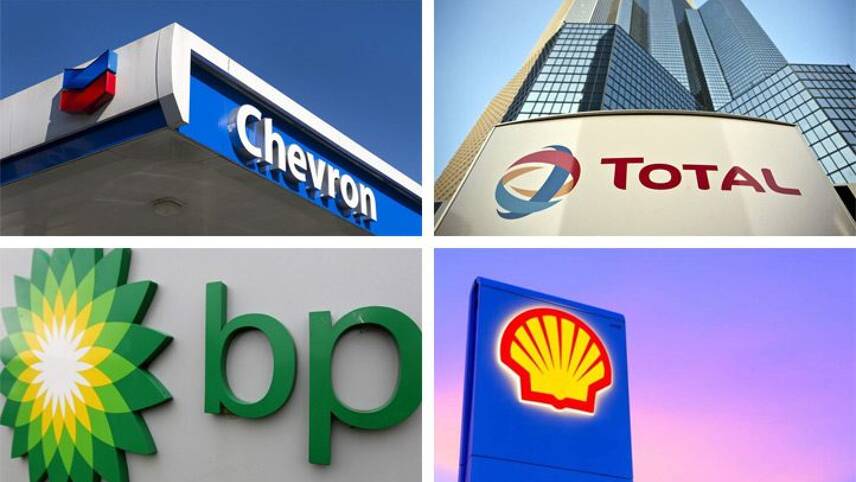Register for free and continue reading
Join our growing army of changemakers and get unlimited access to our premium content

This round-up explores the low-carbon actions being taken by seven of the world's largest energy majors: BP
Driven by a history of political lobbying and high-performing growth margins, the oil and gas industry accounts for around 3% of global GDP and more than 50% of global emissions associated with energy consumption.
This history has come at the expense of the environment; a new Friends of the Earth report published as recently as this week concluded that the sector is responsible for £44bn worth of costs through environmental damage, negative social impacts and healthcare spending annually.
However, the energy sector is faced with an unprecedented transition and – whether driven by economic opportunities or an understanding of climate impacts – the major players in the sector are starting to align to a low-carbon transition.
Faced with an adapt-or-die outlook, several of the industry’s largest companies have unveiled fresh carbon ambitions, low-carbon investment schemes or updated energy projections in recent months. With this in mind, edie is examining the precise commitments and actions seven of the world’s largest energy firms have made to adapt to the low-carbon transition.
BP<img title="" src="/admin/news/
Pledges: BP is striving to generate reductions of 3.5m tonnes of CO2 equivalent annually throughout the business by 2025 as part of its Advancing the Energy Transition (AET) strategy. Launched in April 2018, BP claimed the strategy would help it to keep net greenhouse gas emissions at 2015 levels as the business expands. Following pressure from investors, the firm has additionally pledged to align its business with the aims of the Paris Agreement and link staff bonuses to decarbonisation.
Energy outlook: Published in February, BP’s latest energy outlook report predicts that renewables will account for 30% of global electricity supply by 2040 – up from just 10% in 2018. The figure is an increase on 2018 predictions, which set the 2040 proportion for renewables at 25%.
Low-carbon investments: Last year, UK-based BP returned to solar power with the $200m investment in solar developer Lightsource and made a further major investment in rapid charging points for electric cars at its petrol stations. The move came after BP launched a ‘target zero’ campaign in the UK to encourage its customers to offset their vehicle emissions.
BP also pledged in 2018 to invest a further $500m in low-carbon projects and technologies by the end of 2019, but has yet to post a progress update on this commitment. A further $100m investment in upstream oil and gas emissions reductions projects has since been announced. To put these figures into context, the firm’s full-year underlying profits were $6.2bn in 2017 and is estimated to spend around $30m annually on climate-focused branding and communications.
Policy lobbying: BP has long been targeted by climate activist groups for its continued reliance on crude oil, and for lobbying the Australian government not to sign the Kyoto Protocol unless the US did in the 1990s. More recently, BP has faced accusations that it donated $13m to a campaign that successfully stopped a carbon tax being implemented in Washington state – $1m of which was spent on social media advertising.
Royal Dutch Shell
<img title="" src="/admin/news/
Pledges: Building on its commitment to reduce the carbon footprint of its energy products by 20% by 2035, rising to 50% by 2050, Shell pledged in December 2018 to set shorter-term targets every three to five years, starting in 2020. Effective as of 1 January 2019, the first of these short-term commitments is to deliver a 2-3% reduction of the company’s overall carbon footprint against a 2016 baseline. The company is also aiming to reduce the methane emissions intensity of its operations to below 0.2% by 2025.
In order to deliver these results, Shell has been promising to set a science-based target since 2015 and has begun to align low-carbon action with executive pay.
Energy outlook: In the wake of the Intergovernmental Panel on Climate Change’s landmark report, Shell recently stated that it “agrees” with the need to “transform” the global economy to achieve a 1.5C pathway.
Its most recent energy outlook states that global demands for oil and gas will be higher in 2030 than today – but that the share of oil, gas and coal in the overall energy system will fall as more renewables come online. Specifically, it states that even in the “most rapid” low-carbon transition, oil and gas demand will grow 1% per year from 2020-25 before peaking mid-decade and falling 1% per year between 2026-40. The company is currently aligned with this scenario, which it claims is in line with a 2C trajectory.
Low-carbon investments: The Dutch firm committed in 2018 to spend $1bn-$2bn annually on clean energy projects and research by 2020, with the rest of its total $25bn budget invested in hydrocarbons. It has begun assessing the feasibility of doubling this budget again to $4bn (£3.2bn).
So far, Shell has installed rapid electric vehicle (EV) charging points and hydrogen cell refuelling facilities at some of its petrol station forecourts. The company has also invested heavily in a number of smaller low-carbon ventures in recent times as it seeks to green its portfolio, including onsite renewables firm Cleantech Solar, smart energy storage startup Sonnen, EV charging network NewMotion and ‘virtual power plant’ host Limejump. It additionally spends around $53m on climate-related communications each year.
However, the firm confirmed in 2018 that it would re-invest in North Sea projects for the first time in six years – a move that will increase its UK oil production by a third.
Policy lobbying: Shell has faced widespread criticism for failing to reveal that its own research, carried out in 1988, had predicted the global damage that would be done by its fossil fuel projects – and for investing $49m in climate lobbying annually.
But in recent times, the company has publicly called for the introduction of a stricter carbon tax and greater policy support for wind power. Shell is a member of The Carbon Trust’s Offshore Wind Accelerator (OWA) scheme, for example, which sees businesses commit to funding research and development of technology that will reduce the cost of offshore wind.
In April 2019, Shell became the first oil and gas major in history to announce that it will leave pro-oil lobby group American Fuel & Petrochemical Manufacturers (AFPM). It will quit the body in 2020 after claiming that its views on climate change are “not aligned”.
Ørsted<img title="" src="/admin/news/
Pledges: After renaming from DONG (Danish Oil and Natural Gas) in 2017, Ørsted pledged to reduce its overall carbon footprint by 96% by 2023, against a 2006 baseline. The company will phase-out its coal-related business aspects by 2023, which include the divestment of its upstream oil and gas business. After this point, it will continue to trade in and sell natural gas to its customers.
Ørsted has also committed to increasing its wind portfolio to 15GW by 2025, rising to 30GW by 2030.
Action so far: As of October 2017, Ørsted had achieved a 52% reduction in its overall carbon footprint against a 2006 baseline. It currently has a 25% market share in the European offshore wind sector and has 11 offshore wind farms in the UK alone, with a total portfolio capacity of 11.9GW.
Low-carbon investments: Before its rebrand, the firm began to finance and construct the world’s first biogas plant that can handle unsorted and untreated household waste, which will be built in Northwich in Cheshire. The facility is due to power 9,500 homes when it is completed this year and will be operated by Ørsted.
More broadly, Ørsted is set to invest DKK 200bn (£22.9bn) in clean power by 2025, of which 75-85% will be funnelled into offshore wind and up to 5% will be earmarked for bioenergy, with the remainder set to be spent on onshore wind.
Policy lobbying: Orsted sees wind power as its main focus and is aiming to bring offshore wind to 30 million customers by 2025. It is therefore unsurprising that it publicly lobbied for planners to give the green light to the world’s largest offshore windfarm.
Even before its rebrand, the firm has been a long-standing advocate for policies which could spur the low-carbon transition. In 2011, it told the European Commission that it would welcome more ambitious carbon and climate targets from national governments and international bodies, and a year later called for the EU to set legally enforceable targets for 2030 in emissions reductions, renewable energy and energy efficiency.
Equinor<img title="" src="/admin/news/
Pledges: After rebranding from Statoil, Equinor pledged to achieve annual CO2 reductions of three million tonnes by 2030, against a 2017 baseline. It has also committed to allocating at least 15% of its capital expenditure (CAPEX) for renewables by the same deadline. A further 2030 commitment is the elimination of flaring. Its overall vision is for a “low-carbon, high-value portfolio”.
Action so far: Since 2011, Equinor has recorded a 30% reduction in its overall carbon footprint and has reduced the methane intensity of its operations to 0.03%. Much of this progress to date has been driven by energy efficiency schemes throughout its supply chains and direct operations.
Low-carbon investments: By 2025, Equinor expects low-carbon energy solutions and energy efficiency products to account for 25% of its R&D funding, with renewables set to account for a further 15-25%. It has been involved in offshore wind projects for a decade and has invested $2.3bn in the sector to date, but began its foray into solar somewhat later, with an agreement to acquire a 40% share of the 162MW Apodi solar farm in Brazil.
Equinor is also involved with the development of a carbon capture and storage value chain in Norway and a string of smaller-scale hydrogen and geothermal schemes.
In order to spur the development of emerging clean energy technologies, the firm launched its $200m Energy Ventures Fund in 2016. Firms to have received support from the initiative include EV charging network operator ChargePoint, solar tech firm Oxford PV and Fos4X, which develops sensors to optimise wind turbine performance.
Policy lobbying: In 2015, Statoil chief executive Eldar Saetre made headlines when he claimed that there was “no way the world is getting out of oil and natural gas production”. Since then, he has changed his stance and recently said that climate change is “in fact a real threat to our license to operate, unless we proactively and collectively address it”.
But the firm’s past stance on climate change continues to be the subject of criticism, largely because it was coupled with a sizeable investment and lobbying drive. Research in 2013 found that Statoil had spent $5.5m on anti-climate lobbying in the US since 2001, for example, while its US arm remains a member of the American Petroleum Institute (API). The API has also received support from the likes of Chevron and has been accused of spending $65m annually on blocking climate action and supporting policymakers who support the crude oil industry.
Total<img title="" src="/admin/news/
Pledges: Total is aiming for “green” natural gas to make up at least 60% of its hydrocarbon portfolio by 2035 and to have renewable power account for one-fifth of its portfolio by 2046. It is also hoping to decrease flaring by 80% by 2020, against a 2010 baseline, with the elimination of flaring set to be completed in 2030.
Action so far: Total reduced its overall carbon footprint by 30% and claims this will set it up to align with a 2C trajectory in the near future. It ceased coal operations in 2016 and recorded an 87% decrease in flaring and a 14% improvement in energy efficiency between 2010 and 2017. To date, it has installed 7GW of solar capacity globally.
Low-carbon investments: To date, Total has invested around $160m in 20 cleantech startups across its core markets, including businesses in the lithium-ion battery, microbial fuel and sugar energy recovery spheres, and in 2016, it acquired French battery firm Saft for $1bn. As for renewable energy, the firm is part of several clean energy partnerships, including with Abu Dhabi’s Shams1 solar thermal plant, US-based renewables firm Sunpower and Belgian company EREN Renewable Energy.
Total is also investing heavily in energy storage, and earmarks 10% of its annual R&D spending for lithium-ion battery schemes.
Policy lobbying: Total is estimated to spend around $52m on climate-related campaigns every year, but has also been accused of spending more than $25m annually on delaying, controlling or blocking policies to tackle climate change.
Less recently, the firm played a key role in in the launch of Paying for Carbon, a call to governments to introduce a carbon pricing mechanism. It is additionally a member of The World Bank’s Carbon Pricing Leadership Coalition and the UN Global Compact’s Business Leadership Criteria on Carbon Pricing initiative.
Chevron<img title="" src="/admin/news/
Pledges: Chevron has not yet set any targets relating to the reduction of its carbon footprint, but stated in its latest climate report that such aims will be developed before the end of 2019. Elsewhere, it is aiming to reduce methane and flaring intensity by up to 30% from 2016 levels by 2023. In 2017, it issued its sustainability strategy through contributions to the Sustainable Development Goals (SDGs) and earlier this year pledged to link executive pay to low-carbon progress.
Energy outlook: Chevron bases its energy outlook on that provided by the International Energy Agency (IEA) and has predicted that crude oil and natural gas will still account for almost half (48%) of the world’s primary energy mix by 2040. By this date, the firm believes coal will account for 13% of the energy mix, with the rest accounted for by nuclear, bioenergy and other “clean” sources.
Low-carbon investments: The company has invested in five solar projects with a combined 73MW of power capacity to date and fully owns a and a 16.5MW wind farm. It also has an equity stake in a 49MW geothermal joint venture.
Away from renewables, Chevron has invested more than $75m in R&D projects for carbon capture and storage (CCS) over the past 10 years and has funnelled $1.1bn into the Gorgon carbon dioxide injection project and the Quest project in Canada, which both aim to decarbonise fossil fuel extraction and use.
Policy lobbying: Chevron is estimated to spend $4m per year on advertising and communications to suggest that it opposes high-carbon products, climate change and rising GHG emissions – but this is reportedly matched by $28m of lobbying to weaken climate legislation.
Chevron denies this accusation and claims that it is “committed to working with policymakers to design balanced and transparent greenhouse gas emissions reductions policies that address environmental goals and ensure consumers have access to affordable, reliable and ever cleaner energy”.
It maintains that it has a “right and a responsibility to its stockholders to advocate positions on proposed policies that will affect the company’s ability to explore for and produce energy.”
Chevron claims that it spent $21.2m in 2018 on political contributions, all of which was used to “support candidates and political organizations who foster economic development, free enterprise and good governance”. Chevron notably joined the Oil and Gas Climate Initiative (OGCI) in 2018.
ExxonMobil<img title="" src="/admin/news/
Pledges: The firm is yet to set any long-term carbon or GHG targets and has been accused by CDP of having failed to set even short-term goals. However, it is planning to reduce its methane emissions by 15% and flaring at gas sites by 25% by 2020, against a 2017 baseline.
In April 2019, the Securities and Exchange Commission ruled that Exxon shareholders would not be given the chance to vote on whether the firm should set long-term emissions targets this year.
Action so far: ExxonMobil claims to have spent $9bn on technologies to lower emissions since 2000, including carbon capture, biofuels and flare reduction. Since 2008, its net GHG footprint has decreased from 126 million metric tonnes of CO2e to 122 million metric tonnes of CO2e.
Energy outlook: ExxonMobil’s latest energy outlook predicts that global energy demands will increase by 25% by 2040. At this date, the firm believes global CO2 emissions are likely to “peak”. It has forecast a 400% growth in the solar market and a “large expansion” of the uses open to natural gas by this time, but also believes that oil will still account for around one-fifth of the global energy mix.
Low-carbon investments: One of the firm’s largest low-carbon investments is in biofuels; it is set to spend $500m on a partnership with Synthetic Genomics which will genetically engineer renewable crude oil from sunlight and carbon dioxide. The aim is to produce 10,000 barrels per day by 2025 – equivalent to 0.2% of its capacity. Elsewhere, ExxonMobil last year invested in a 250MW solar array and a 250MW wind farm in Texas, and is reportedly investing $1bn annually into other green research and development projects.
Policy lobbying: ExxonMobil reportedly spent the most on climate-focused branding last year of any oil and gas major, with its spend in this area estimated to stand at around $55m. During the 12-month period, its lobbying spend totalled $41m.
ExxonMobil claims that its team of scientists have been involved in climate change research and related policy analysis for more than 35 years, contributing to more than 50 peer-reviewed publications.
However, ExxonMobil has been dubbed by many as a key influence in preventing ratification of the Kyoto Protocol by the US, and was a founding member of the board of directors of the Global Climate Coalition, which formed in the 1990s and was composed of businesses opposed to greenhouse gas emission regulation. Since the resignation of its former chief executive Lee Raymond in 2006, it has changed its stance and now supports the carbon pricing system.
Sarah George









What you have to remember is only 45% of a barrel of oil goes to fuel. The remainder goes to the petrochemical industry to make the millions of everyday products our modern life demands and needs. From pharmaceuticals to lipstick, plastic to synthetic clothing, medical equipment to mobile phones.
Burning it may decrease but people like me will still be heading out into the worst Mother Nature can throw at us to find and develop the raw material all these things are made of for years to come.
Keiron, I don’t think that’s right. According to the US Government Agency, the EIA, in the USA in 2017 on average 47% was motor gasoline (includes ethanol), 20% was distillate fuel (heating oil and diesel fuel), and 8% was jet fuel. The balance was used for fuel oils for heating and electricity generation; asphalt and road oil; and feedstocks for making the chemicals, plastics, and synthetic materials. By my reckoning at least 75% is burned one way or another. See https://www.eia.gov/tools/faqs/faq.php?id=41&t=6. In Europe we tweak the barrel to produce more middle distillate (diesel) and less petrol.
The fraction that goes to chemicals may be a little higher in NW Europe (Rotterdam and Antwerp in particular), but globally I wouldn’t expect them to be much different from the US figures.
Ian, the 45% came from an infographic produced by the API (American Petroleum Institute) a few years ago so could well be out of date but the fact that oil has many more uses than just burning is still true though regardless of the actual %
Modern life relies on petrochemicals and petroleum based products. Yes some may be replaceable with biological alternatives at some point but not all. That isn’t going to change overnight so the oil industry will still be hunting for and developing new reserves of oil (and gas) for a long time and we will continue to do it in as environmental sensitive manner as we possibly can, which contrary to popular belief we do do.